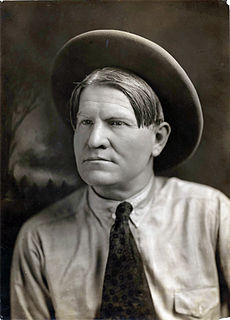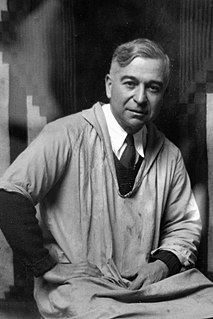Related Research Articles

Orvon Grover "Gene" Autry, nicknamed the Singing Cowboy, was an American singer, songwriter, actor, musician, rodeo performer, and baseball owner who gained fame largely by singing in a crooning style on radio, in films, and on television for more than three decades beginning in the early 1930s. Autry was the owner of a television station, several radio stations in Southern California, and the Los Angeles/California Angels Major League Baseball team from 1961 to 1997.

Charles Marion Russell, also known as C. M. Russell, Charlie Russell, and "Kid" Russell, was an American artist of the American Old West. He created more than 2,000 paintings of cowboys, Native Americans, and landscapes set in the western United States and in Alberta, Canada, in addition to bronze sculptures. He is known as "the cowboy artist" and was also a storyteller and author. He became an advocate for Native Americans in the west, supporting the bid by landless Chippewa to have a reservation established for them in Montana. In 1916, Congress passed legislation to create the Rocky Boy Reservation.

Thomas Moran was an American painter and printmaker of the Hudson River School in New York whose work often featured the Rocky Mountains. Moran and his family, wife Mary Nimmo Moran and daughter Ruth took residence in New York where he obtained work as an artist. He was a younger brother of the noted marine artist Edward Moran, with whom he shared a studio. A talented illustrator and exquisite colorist, Thomas Moran was hired as an illustrator at Scribner's Monthly. During the late 1860s, he was appointed the chief illustrator for the magazine, a position that helped him launch his career as one of the premier painters of the American landscape, in particular, the American West.

Joe Neil Beeler (1931–2006) was an American illustrator, artist and sculptor specializing in the field of Western art. In 1965, he cofounded the Cowboy Artists of America (CAA) with Charlie Dye, John Hampton and George Phippen.

William Surrey Hart was an American silent film actor, screenwriter, director and producer. He is remembered as a foremost Western star of the silent era who "imbued all of his characters with honor and integrity." During the late 1910s and early 1920s, he was one of the most consistently popular movie stars, frequently ranking high among male actors in popularity contests held by movie fan magazines.

Joseph Jacinto Mora was a Uruguayan-born American cowboy, photographer, artist, cartoonist, illustrator, painter, muralist, sculptor, and historian who lived with the Hopi and wrote about his experiences in California. He has been called the "Renaissance Man of the West".
Western lifestyle or cowboy culture is the lifestyle, or behaviorisms, of, and resulting from the influence of, the attitudes, ethics and history of the American Western cowboy. In the present day these influences affect this sector of the population's choice of recreation, clothing, and consumption of goods.
William Roderick James was a Canadian-American artist and writer of the American West. He is known for writing Smoky the Cowhorse, for which he won the 1927 Newbery Medal, and numerous "cowboy" stories for adults and children. His artwork, which predominantly involved cowboy and rodeo scenes, followed "in the tradition of Charles Russell", and much of it was used to illustrate his books. In 1992, he was inducted into the Hall of Great Westerners of the National Cowboy & Western Heritage Museum.
James Kenneth "J.K." Ralston was an American painter of the Old American West whose primary topics were the American West and images of cowboys and American Indians. He also did commercial artwork.

Robert "Bob" Coronato is an American painter and printmaker. Coronato is best known for his paintings of present-day Western Americana, cowboys, and American Indian life and culture.
Herman Wendelborg Hansen (1854-1924) was a 19th-century artist, well known for his Western-themed paintings featuring horses, cowboys, and the frontier.
The 1956 Wyoming Cowboys football team represented the University of Wyoming in the Skyline Conference during the 1956 NCAA University Division football season. In their fourth season under head coach Phil Dickens, the Cowboys compiled a perfect 10–0 record, won the Skyline Conference championship, and outscored all opponents by a total of 252 to 112. The Cowboys were ranked No. 19 in the AP Poll issued on November 19, 1956, but dropped out in the final poll.

Southern Plains Indian Museum is a Native American museum located in Anadarko, Oklahoma. It was opened in 1948 under a cooperative governing effort by the United States Department of the Interior and the Oklahoma state government. The museum features cultural and artistic works from Oklahoma tribal peoples of the Southern Plains region, including the Caddo, Chiricahua Apache, Comanche, Delaware Nation, Kiowa, Plains Apache, Southern Arapaho, Southern Cheyenne, and Wichita.
Earl Heikka was an American sculptor. He designed figurines and statues of the Old West, miners, and horses. He committed suicide at age 31.
Edward Borein (1872–1945) was an American etcher and painter from California. His artwork depicted Spanish Colonial California, the Old West, and Mexico.
Olaf C. Seltzer was a Danish-born American painter and illustrator from Great Falls, Montana. He did over 2,500 paintings and illustrations of the American West, including cowboys.
Robert Lindneux was an American painter from Denver, Colorado. He did paintings of the Old West, including Native Americans like Quanah Parker and pioneers like Buffalo Bill.

Richard Gordon Matzene, born Jens Rudolph Matzene, was a European-born American photographer and art dealer. He took many portrait photographs of members of high society.
Bud Helbig, born Erwin E. Helbig, was an American painter, illustrator and sculptor. His artwork depicted the American West, especially cowboys.
Nick Eggenhofer was a German-born American painter, illustrator and sculptor of the American West. He was the author of two books.
References
- 1 2 3 4 5 6 7 "Talk: Joe De Yong: A Life in the West". Santa Barbara Historical Museum. Retrieved December 12, 2018.
- 1 2 "Montana Artist Is On Way To Success" . The Billings Weekly Gazette. Billings, Montana. August 14, 1923. p. 12. Retrieved December 12, 2018– via Newspapers.com.
- 1 2 3 "Work of Joe De Yong featured in gallery" . Santa Maria Times. Santa Maria, California. September 15, 1976. p. 8 – via Newspapers.com.
- ↑ Gagliasso, Dan (Autumn 2000). "Joe De Yong and Hollywood". Montana: The Magazine of Western History. 50 (3): 2 – via ProQuest.
- 1 2 "Images from the Joe De Yong & Richard J. Flood Collection". National Cowboy & Western Heritage Museum. Retrieved December 12, 2018.
- ↑ "Western art dealer, collector Flood dies" . Great Falls Tribune. Great Falls, Montana. September 23, 1993. p. 12. Retrieved December 12, 2018– via Newspapers.com.